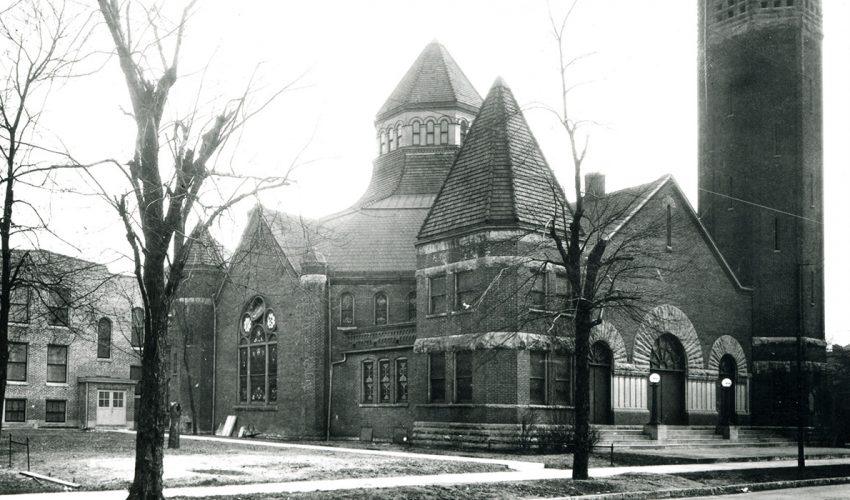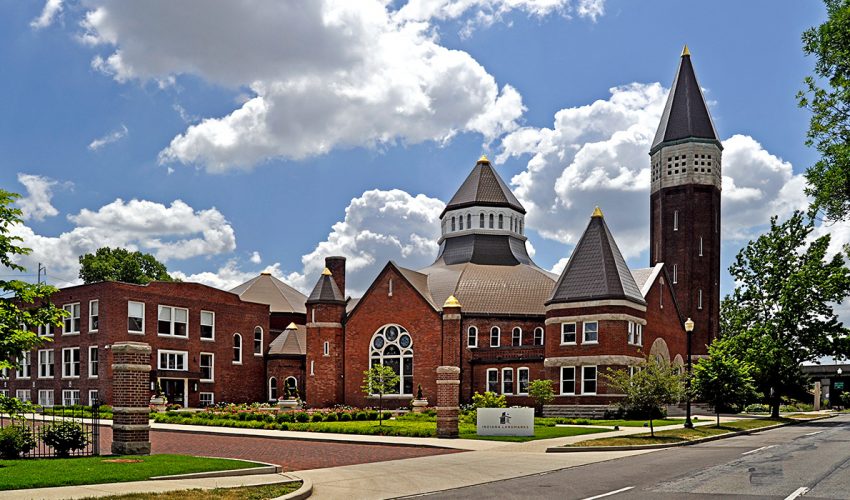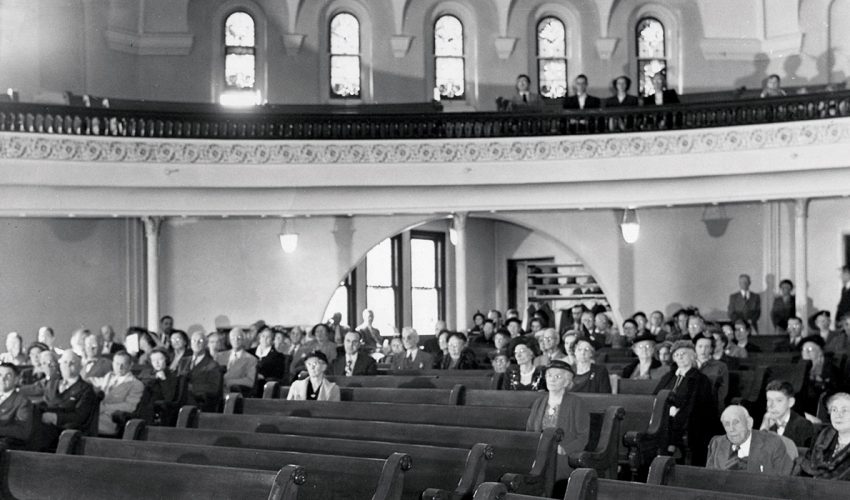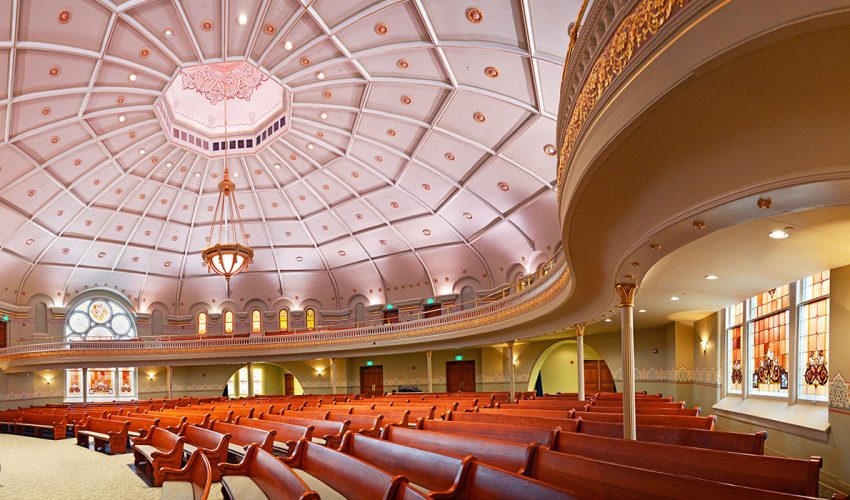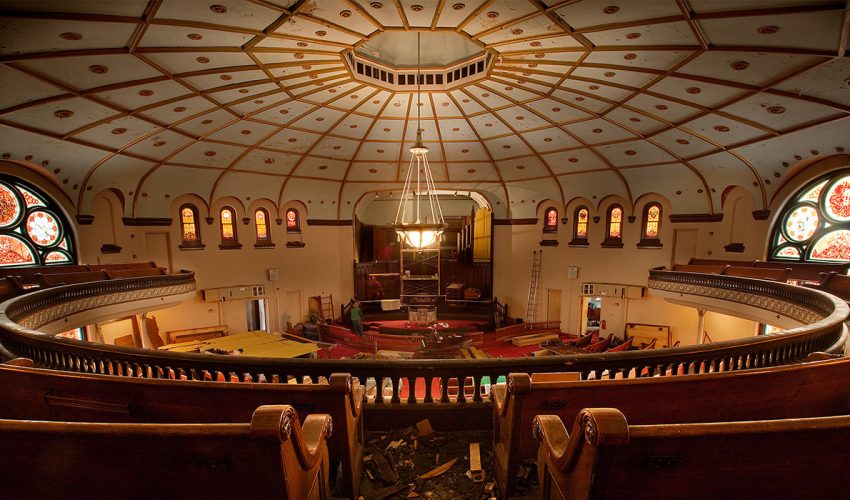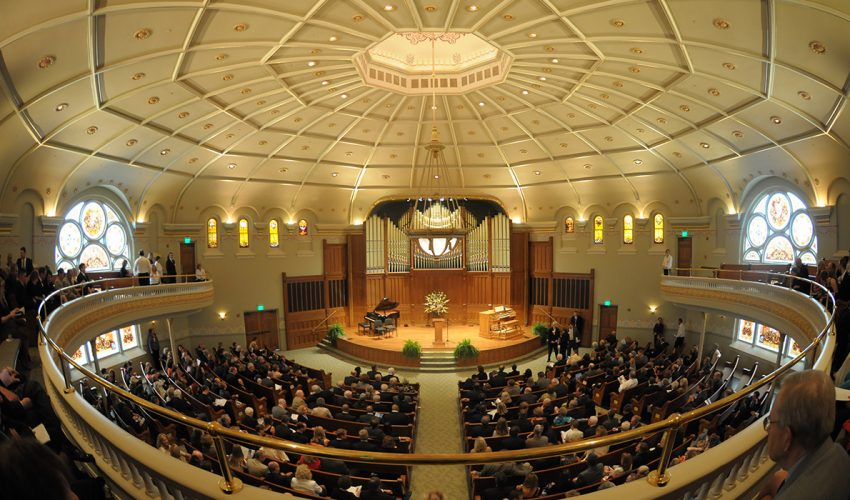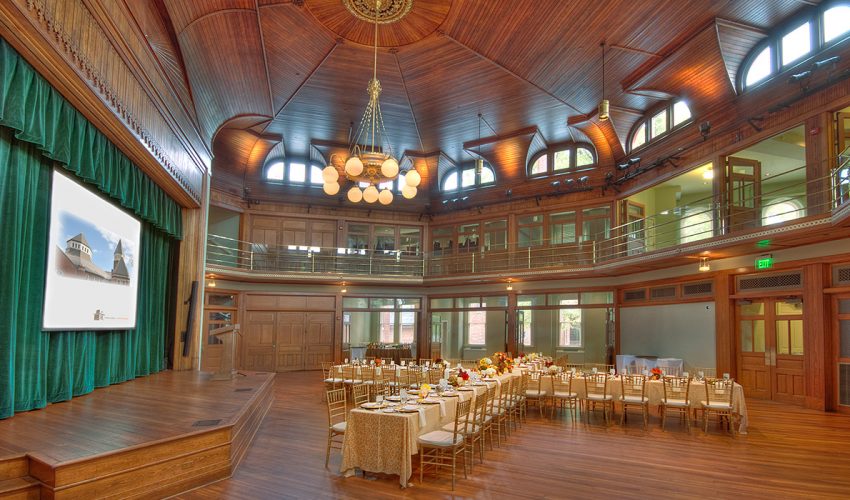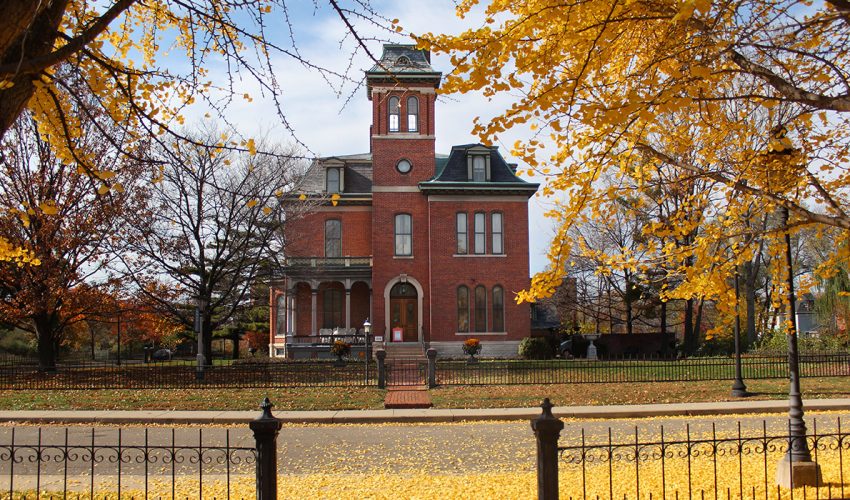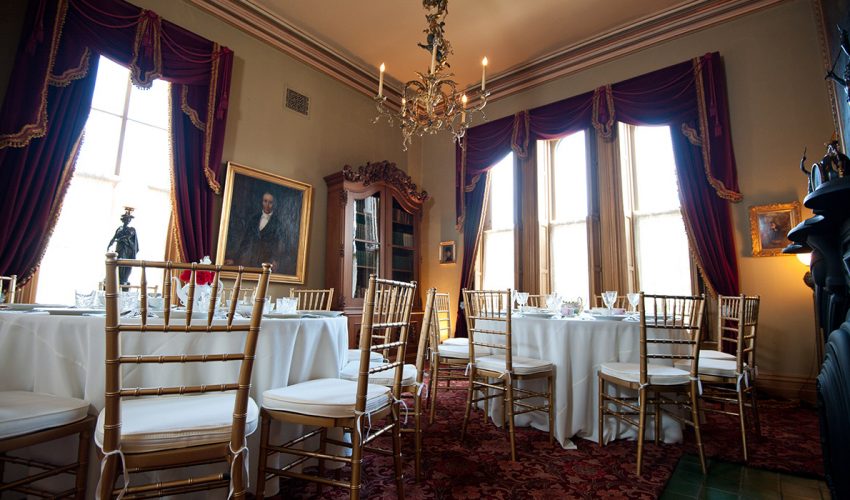Indiana Landmarks Campus
A Historic Place to Meet, Play, Love
Our campus combines a stunningly adapted nineteenth-century church complex—a $19 million restoration and repurposing—and an antique-filled Victorian mansion. We use the beautiful venues for our own meetings and events and rent them to others.
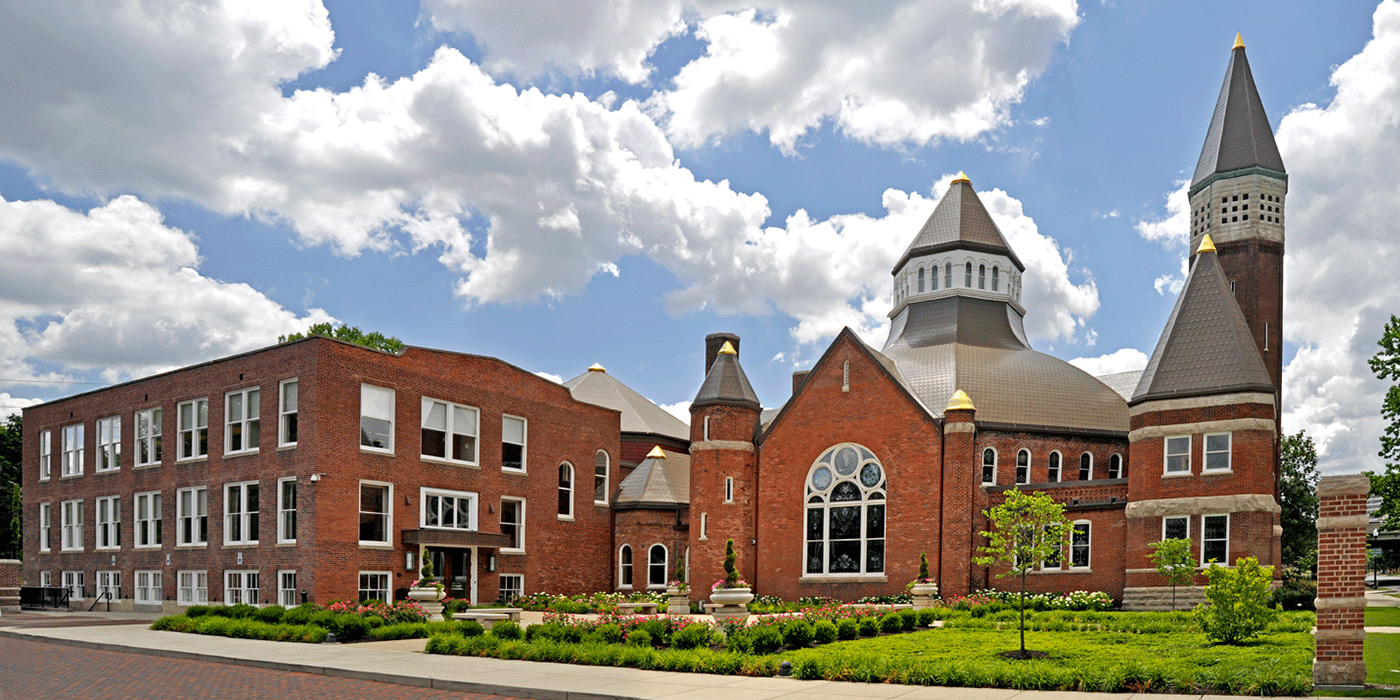
A Special Place for Special Occasions
A restored, Romanesque Revival-style church with spaces to fit gatherings and events of all sizes, Indiana Landmarks Center is the focal point of our Indianapolis campus, and serves as Indiana Landmarks’ headquarters. Located in the Old Northside neighborhood of Indianapolis, a district listed in the National Register of Historic Places, the property includes a landscaped courtyard and on-site parking.
Venues on the campus host banquets, weddings and receptions, performances, fundraisers, seminars, meetings, lectures, films, and other special events.
The spectacular Grand Hall, the former sanctuary, features state-of-the-art sound and lighting systems. Stenciling, gilding, and spectacular stained-glass windows enrich the space under an ornate domed ceiling. Cook Theater, a rich all-wood space with a proscenium stage, allows flexible seating arrangements for performances, dinners and receptions.
Other handsome venues include Rapp Family Gallery, meeting rooms of various sizes (such as the Morrow Board Room) and the outdoor Place de Basile. Next door, the 1865 Morris-Butler House offers additional rental spaces furnished with antiques, including a formal parlor, dining room, and library. (Download a summary of venue specifications here.)
Rental Inquiries
Interested in learning more about renting a venue at Indiana Landmarks Center? We’d love to show you around. Use the form below to tell us more about your event, and a member of our team will follow up soon.
Contact Us
1201 Central Avenue
Indianapolis, IN 46202
317-639-4534, 800-450-4534
Tours of Indiana Landmarks Center
Explore the $19 million transformation of a nineteenth-century landmark church as a cultural and performance venue. On the first Friday of select months, Indiana Landmarks hosts a free art show featuring works by Indiana-based artists, past and present, in Indiana Landmarks Center’s Rapp Family Gallery. During First Friday shows, guests can also see the stunning architecture of Indiana Landmarks Center’s grand spaces.
To arrange a group tour of Indiana Landmarks Center on the date and time of your choosing for a fee, contact our heritage tourism office, 317-822-7951, tourism@indianalandmarks.org.
History & Restoration
Indiana Landmarks Center shows that when a great historic building loses its original purpose, it need not be the end of the story. The Romanesque Revival-style building at 1201 Central Avenue began life in 1891 as Central Avenue Methodist Church, with additions in 1900 and 1922. For decades it housed the largest Methodist congregation in the state.
Founder of Methodist Hospital and Wheeler Mission, the church’s congregation exerted a shaping influence on the city of Indianapolis and beyond. In the last half of the twentieth century, members of the congregation included Senator Richard Lugar, Congressman Lee Hamilton and the late Governor Frank O’Bannon and his wife Judy.
Borrowing from theater architecture, Williams and Otter designed the 1891 sanctuary (now Grand Hall) in the auditorium style, which put the focus on the pastor and the pulpit. The radiating aisles, slanted floor, curvilinear pews, and curved balcony gave everyone an equally favorable and focused view of the pastor. The church added the Sunday school (now Cook Theater), in 1900 following the Akron Plan, an architectural design popular in Protestant churches at the turn of the 20th century that featured a large common space ringed by smaller rooms. In 1922, the church grew with yet another addition (now Indiana Landmarks’ state headquarters).
The post-World War II decline of Indianapolis’s inner-city neighborhoods also brought changes to most nineteenth-century churches. Congregations shrank with the exodus of the population to the suburbs, leaving congregations too small to support aging buildings. Landmark churches deteriorated under years of deferred maintenance. This happened at Central Avenue United Methodist Church, a local example of a nationwide trend.
In the 1950s, the Central Avenue church helped start St. Luke Methodist Church in a northern suburb. That forward-thinking, mission-driven act marked the beginning of a long decline for the inner-city church. When the remaining congregation of less than 30 merged with another Methodist church in 1999, the denomination gave the complex to the Old Centrum Foundation, a new nonprofit created to restore the church and operate it as a community center filled with small nonprofits.
Though it was a good steward and tried hard to maintain the building, Old Centrum could not adequately address dilapidation caused by long-deferred maintenance. The organization closed the building in March 2008. Old Centrum appealed to Indiana Landmarks to find a solution that would save the place. In April 2008, the rusty, leaking roof caused a 30-foot section of the domed sanctuary ceiling to fall, crashing down on pews. Some called the place a lost cause.
Rescued and repurposed as Indiana Landmarks Center, the complex reopened in 2011 after a $19 million renovation that turned the sanctuary into a theater, the Sunday school into Cook Theater, and the school and office wing into the Indiana Landmarks’ headquarters. Our supporters Bill, Gayle and Carl Cook of Bloomington directed the restoration and funded $16 million of the cost.
The three-building complex creates a campus with Morris-Butler House, immediately east at 1204 North Park Avenue, the first structure restored by Indiana Landmarks after its founding in 1960. Indiana Landmarks Center campus is located in the Old Northside neighborhood of Indianapolis, a district listed in the National Register of Historic Places.

